Frozen Pipes? Here’s What to Do
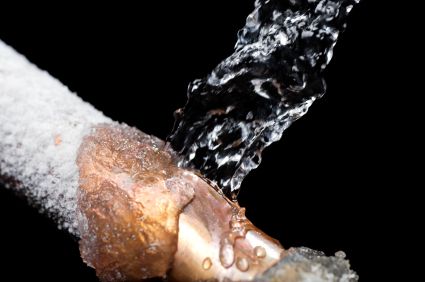
Turning on the faucet or shower on a cold morning and having no water come out of the tap is a scary situation. When pipes freeze, the water inside them expands. Eventually, the pipes and fixtures can’t contain the pressure and so they burst, sometimes a filling a house with water that gushes from the rupture. According to State Farm, the average insurance claim related to frozen pipes is $15,000. Even though a thaw is allegedly on it’s way, that doesn’t mean the risk is gone. Often when frozen pipes start to thaw is when they rupture.
So what do you do about frozen pipes? If you have frozen pipes now, the first thing is to check the other taps in the house. If all the fixtures are affected, you know it’s the main line coming from the well or municipal water supply. If you know where your water meter is located, that’s a good place to start warming the main line. You can heat the main line with a hair dryer, heating pad, or electric blanket. Also, try your best to warm the space around the main line by opening or closing doors, cranking up the thermostat, and perhaps using space heaters. Don’t use a torch to thaw the pipes, as the risk of fire is too great. In fact, the incidence of house fires goes way up during cold spells as folks improvise various methods to keep their pipes and homes warm.
If your frozen pipes are in a more local area, such as a single fixture or a bathroom, look in the basement or crawlspace for the water lines that supply the affected part of the house. You should follow the pipes backward from the affected fixture, feeling along their length for cold spots. Pipes that run through garages, crawlspaces, and exterior walls are especially prone to freezing, so check out any exposed pipes in those locations. Start warming the coldest section of piping you can access with the methods described above. You often don’t have to find the exact spot where the pipe is frozen, as any heat applied down the line will gradually move toward the frozen section on its own. If you can’t thaw the pipe on your own, call a plumber to thaw it before it bursts.
To prevent pipes from freezing in the future, seal any air leaks that allow cold outside air to come in contact with your home’s piping. Look for holes in the home’s exterior and any holes in the framing through which the pipes are routed. These holes are often left unsealed, and the resulting air leaks allow cold air to come in contact with the pipes while at the same time displacing warm interior air that keeps the pipes warm. You can insulate the pipes that run through unconditioned spaces, but it’s better to move them to a warmer spot if possible.
If you have pipes prone to freezing, you should keep cabinet doors and bathroom doors open during cold spells to allow warm interior air into the space. Consider using space heaters in places where pipes have frozen in the past. Disconnect hoses from outside spigots, and turn up the thermostat if you’re expecting especially cold temperatures.
When building and remodeling, don’t route pipes through exterior walls or through unconditioned attics and crawlspaces, and be sure to seal the holes where the pipes and wires go through the framing. When you’re leaving your home for two days or more during cold weather, have a neighbor check on the house every day or two to ensure the heating system is operating. You can also get freeze alarms that call you or your heating contractor when there’s a problem with your heating system. There are also high-tech thermostats that do the same.
More on Frozen Pipes
Fine Homebuilding Recommended Products
Fine Homebuilding receives a commission for items purchased through links on this site, including Amazon Associates and other affiliate advertising programs.

Affordable IR Camera

Handy Heat Gun

8067 All-Weather Flashing Tape
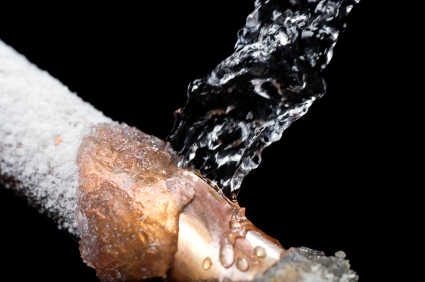
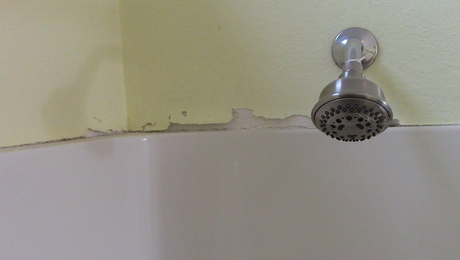


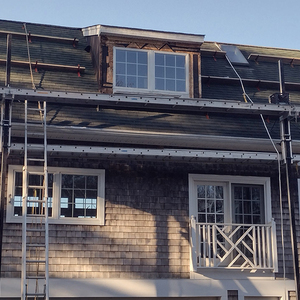
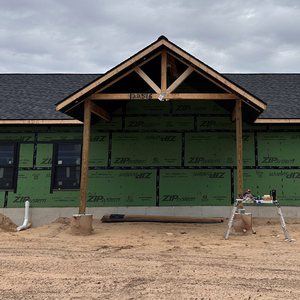


















View Comments
After a week of "record cold," I'd venture this article is a bit late in coming.
I also want to chide those who act as if this winter was the first time anyone ever had cold weather.
That said, I must confess: Last winter my pipes froze. Solid. This had never before, as best I could tell, happened to my house in its' half-century of being there. SO ... what changed?
What changed was, in a word, ME. I had bought the house/ In the course of a major remodel, I had the crawl space wide open. With the water pipes buried in the ground, and only about 24" exposed as the branch lines entered the floor, I didn't worry.
Forget the logic in the main post; each little branch line froze solid.
Immediate solution: "remove the cold" (close off crawl space' let lost house heat slightly warm the area) and OPEN every valve at least a little. By mid-day, the ice melted and water flowed.
Long term? Temperature-responsive heat trace(Raychem) and insulation. Close most crawl space vents in winter.
What you DO NOT want to do is to get under the house with a torch or a blow drier. Ice expands as it thaws, and water does not compress. That's why frozen pipes break as the thaw - not as they freeze - and the pipes split with a BANG.
If you KNOW where the freeze is, you open the valve and start heating the water on the downstream side. Let water pressure push flow through the ice, and melt the plug that way. If you don't KNOW where the plug is, tent off the area and gently heat the AREA around large section of pipe with a non-focused space heater ... one of those "electric radiators" is best. Be PATIENT.
We picked up a cheap freeze alarm here - http://www.absoluteautomation.com/power-alarms/temperature-alarms.html - and it's been doing the trick for us.
In my science classes, water expanded as it froze, not as it thawed. Same with my ice cube trays.
"When water freezes, it increases in volume (about 9% for freshwater)"
https://en.wikipedia.org/wiki/Ice
Pipes, of course, only leak after they thaw as until then there is no flow. Been there, soldered that.
One thing to remember is that there is no such thing as "cold" only lack of heat. If you have water pipes in a cold space, insulation will help but you really need to insulate them in such a way that some heat reaches them. In other words, not a wrap but a box that is open to the heated space above.
There have been many problems with heat tapes causing fires (no doubt due to incorrect installation) but any mobile home owner in a cold climate will have good information on what works.
http://www.bettendorf.org/egov/documents/1204725810_893341.pdf
Here in Minneapolis we get a lot of pipe freezing. Number one, don't set back your thermostat in cold weather. Setback should only be used on forced air heating system, what it was designed for.
For hot water heating, outdoor reset is the answer. On the latest and greatest condensing boilers you will find outdoor reset AND nighttime setback that lowers the design water temperature, slowly, allowing the room to cool off without the typical hazard of freezing pipes--heating and potable--while the boiler stands idle for the lack of a call for heat.
Water does expand frozen from 0°C to 4°C and then shrinks again to a volume of about 10% of its liquid form. It is in the initial expansion that the pipe is burst and in the thawing that it leaks.
How you thaw the pipe will not matter to the water, or the pipe.
In all cases make the house has air-tight and well insulated a practicable is good advice.
All crawl spaces in cold climates should not be vented, should be insulated at the perimeter and a vapor barrier lade on the floor/ground.
Be careful to check that the pipe hasn't burst already and the ice jam is preventing flooding. If the zone can be shut off, then do so. Once the pipe has thawed you can slowly let the water on and check for leaks.
With temperatures reaching 10 degrees here in South Carolina last week this is a very relevant topic. I've also lived in Vermont, so I know colder weather, but homes here aren't typically exposed to these temperatures.
One simple method to prevent frozen pipes is to leave a small amount of water running at the farthest tap from the house supply and/or the most exposed supply. Make sure that water is flowing in both the cold and hot water supply lines.
Many exterior hose bibs are not of the frost free variety (with the seat and washer located 6-12" inside the wall). Adding an insulated cover over these old style valves can reduce the likelihood of freezing and bursting.
I see many cases, especially remodeling projects, where water lines are run in the attic space, often in knee walls for an added upstairs bathroom. Keeping the supply lines on the inside of the insulation and creating an air barrier on the outside off the insulation greatly reduces the chance of frozen pipes. In some cases I've removed wall insulation between supply lines and the back side of bathroom drywall, and then added insulation and rigid foam board insulation boxes around the exterior side of the lines.
Heat cables should be a last resort as power failures, which often coincide with winter storms, will leave you with no protection. I prefer the Raychem self-regulating heat cables such as their Gardian products to the typical Frost King cables with a thermostat. The cables with a thermostat require that that the thermostat be left uninsulated and that the thermostat be located at the coldest point on the line. The Raychem type products on the other hand provide more heat the colder they get, so the coldest point anywhere along the length of the protected pipe will get the the most heating. The Gardian cables can also be used for roof and gutter deicing.
Here's a link to the Raychem cable: http://www.pentairthermal.com/products/heating-cables/self-regulating-heat-trace-cables/index.aspx
I can't say enough about setting your t-stats higher in anticipation of bitter cold weather. Turn the thermostats up 24 hours before the cold snap, and, I mean 10 degrees or more, especially if you have a history of frozen pipes. Thus can be a difference maker, and very cheap insurance.
A home has a better chance of withstanding infiltrating cold air at higher indoor temps, and, the structures warmer mass will continue to contribute to space heating in the event of a power outage or heating system break down.
Know where your main water supply shut ( or water pump circuit breaker ) off is, and use it! When you're away, even for an overnight, shut off the water.
Insulating piping that is routed through unconditioned space will not always prevent freezing. Pipe insulation will reduce velocity noise, prevent condensation, reduce expansion noise, and maintain the heat or cold of the fluid that is in the pipe - insulation does not create heat.
Heat tape should NEVER be used in enclosed, confined, inaccessible areas - all manufacturers of heat take are very explicit about this in their installation instructions.
Leaving a faucet dripping / running in cold weather may result in less than ideal unintended consequences. Chances are that the drain piping is routed through the same cold space as the water supply piping, and, the drain piping can freeze shut due to the trickle of water through the pipe.
pipes burst when they freeze. they don't leak at that time, because ice does not flow. when the ice thaws, the pipe leaks, so you think it just happened now, but it actually happened in january, while you weren't looking. if you have an outdoor faucet, install a frost proof sillcock. turn off the water if you will be gone from your house in cold weather. then there will be no problems.